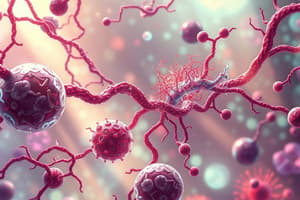Podcast
Questions and Answers
What is the product of glycolysis?
What is the product of glycolysis?
- Adenosine triphosphate (ATP
- Glucose (C6H12O6
- Pyruvate (CH3COCO2H (correct)
- Reduced nicotinamide adenine dinucleotide (NADH
How many reactions are catalyzed by enzymes in the glycolysis pathway?
How many reactions are catalyzed by enzymes in the glycolysis pathway?
- 5
- 8
- 10 (correct)
- 12
Where does glycolysis typically occur in most organisms?
Where does glycolysis typically occur in most organisms?
- The nucleus
- The cytoplasm (correct)
- The mitochondria
- The cell membrane
Flashcards are hidden until you start studying
Study Notes
- Glycolysis is the metabolic pathway that converts glucose (C6H12O6) into pyruvate (CH3COCO2H).
- The free energy released in this process is used to form the high-energy molecules adenosine triphosphate (ATP) and reduced nicotinamide adenine dinucleotide (NADH).
- Glycolysis is a sequence of ten reactions catalyzed by enzymes.
- The glycolysis pathway can be separated into two phases: the investment phase and the yield phase.
- In most organisms, glycolysis occurs in the liquid part of cells, the cytosol.
Studying That Suits You
Use AI to generate personalized quizzes and flashcards to suit your learning preferences.




